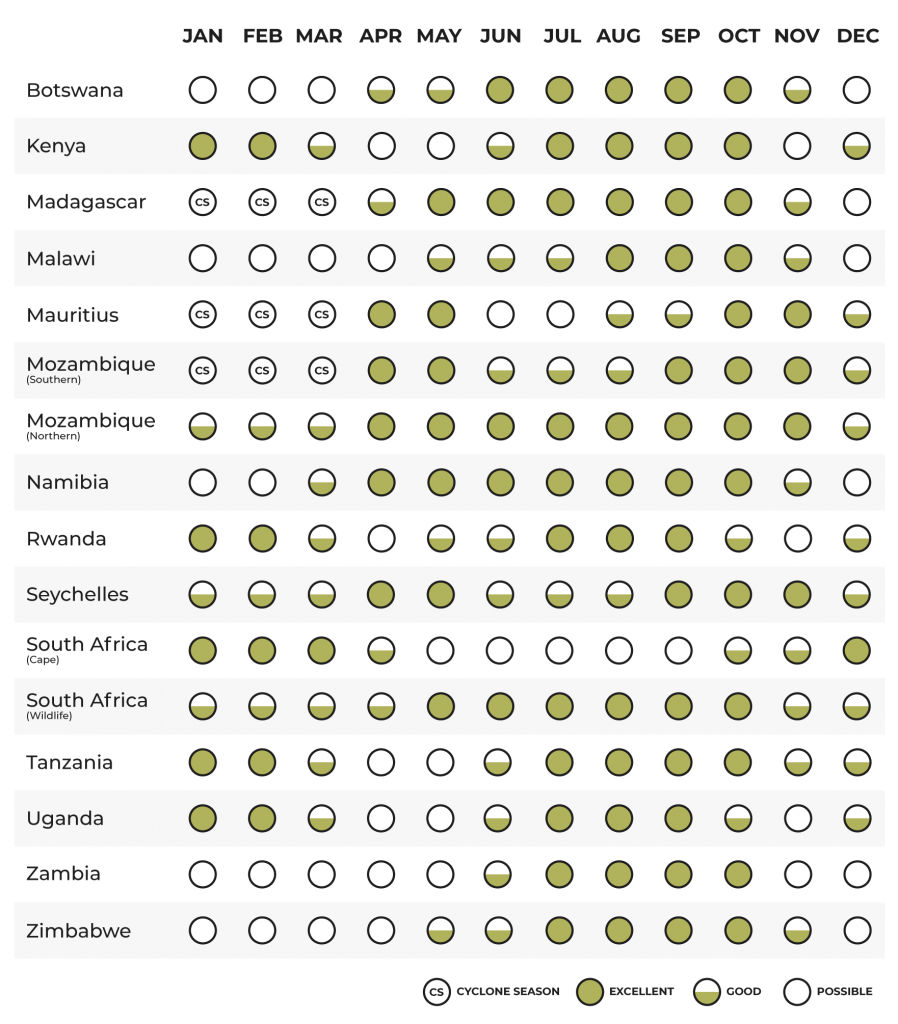Detailed Overview of When to Travel
Wildlife viewing in Africa is generally best during the dry season when the lack of grass and foliage increases visibility, and the animals and birds are forced to congregate around limited water sources. Broadly speaking, the wet and dry seasons across Africa can be described as follows:
Equatorial East Africa (Kenya, Tanzania, Rwanda and Uganda) has its main dry season from June to October, with a secondary drier season from mid-December to mid-March. November is historically known as the time of the ‘short rains’, whilst April and May host the ‘main’ rains.
However, it can rain at any time in East Africa and so the seasons somewhat merge into each other. In particular December to March is rarely rain-free, which is just as well as rain falling in the Serengeti is crucial to keeping the wildebeest herds on the southern short grass plains where they calve.
In southern Tanzania, the weather patterns are a little different as latitudes start to merge with the sub-tropics. Here, it’s more normal to have an extended ‘wet season’ from November through to May. High mountain regions and coastal areas will also follow their own micro-climates.
Sub-tropical Southern Africa (Zambia, Malawi, Mozambique, Zimbabwe, Botswana, Namibia and northern South Africa) has one main dry season which runs from April through to October, and a rainy season from November to March. Although there is some variation in when the rains start each year, and how much falls, annual climatic patterns are generally much more consistent than in East Africa.
The cyclone season in the southern Indian Ocean, affecting Mauritius, Madagascar, and potentially the coastal areas of northern South Africa and Mozambique is from January to March.
The southern half of South Africa, and in particular the Cape region, falls into a Mediterranean-type climate with a winter rainfall from April to October, and a drier summer from November to March.
Back to top »
General Considerations
Each country page on this website has a charter showing the best months to travel. However, as you consider when you might be able to travel, we would also point out the following general influences:
- Whilst game viewing may be generally better in the dry season, this is not exclusively the case. Some regions are unable to support game in the driest times and are better visited when they are green and can provide surface water.
- Birding is often better during the wetter months of the year, when breeding/nesting may take place and migrant species are usually resident.
- Temperatures do not affect game viewing to the same degree but generally in equatorial East Africa, the altitude of a region has more influence on the max/min temperature than the time of year, whilst in sub-tropical Southern Africa and the Cape, there is definitely more of a summer and winter.
- Some regions are so established and/or productive for game viewing that even at the technically ‘wrong’ time of year (i.e. during the rainy season), the game-viewing is still magnificent.
- As weather patterns become harder to accurately predict, and ‘peak’ season prices become increasingly expensive, more people are being flexible about when they travel. Aside from price, there can be definite advantages to travelling in the ‘shoulder’ and ‘low’ seasons (such as fewer other travellers).
Wildlife Highlights Calendar
Below is a wildlife/nature calendar which shows some of the better known and more interesting spectacles throughout the year.
December / January to March
Wildebeest migration concentrated on the southern short grass plains of Tanzania’s Serengeti with calving taking place in late January and early February.
Best-time of year for game viewing in Botswana’s Central Kalahari and Makgadikgadi Pans, with the latter playing host to large concentrations of zebra and flamingo.
Turtle hatching takes place on the Indian Ocean seaboard.
Good birding in southern Africa with migrant summer visitors.
April and May
Botswana’s Okavango Delta begins to flood.
Victoria Falls in peak flow.
South Africa, Botswana and Zimbabwe begin to offer good safari conditions.
Gorillas tend to be at lower altitudes feeding on young bamboo shoots.
Good time to visit Mozambique, Mauritius and Seychelles.
June and July
Okavango Delta in peak flood.
Wildebeest migration moves into the western Serengeti and from there heads north towards Kenya’s Masai Mara.
Southern Right whales arrive off the southern coast of South Africa.
Namibia, Zambia, Tanzania and Kenya begin to offer good safari conditions.
Sardine run off South Africa’s KwaZulu/Natal coast.
August to October
Prime game viewing across most of Africa.
Wild flowers (fynbos and daisy species) in South Africa’s Namaqualand region (August and September only).
Wildebeest migration resident in Kenya’s Masai Mara and Tanzania’s northern Serengeti.
Humpback whales can be seen off the east coast of Africa.
Southern Right whales found in large numbers off the southern coast of South Africa.
Carmine and White fronted bee-eaters start nesting in southern Africa.
Good conditions for pelagic tours off the southern Cape.
September and October
Turtle nesting and egg-laying.
European and Asian migrant birds travel southwards through East Africa to Southern Africa in large numbers.
Heronries start becoming active in Botswana’s Okavango Delta.
Good time to visit Mauritius, Mozambique and Seychelles.
November and December
Turtle nesting and egg-laying begins.
Many mammals drop their young with the onset of the rains (not wildebeest).
Orchid flowering in Malawi’s Nyika Plateau after onset of the rains.
Greater straw coloured bat migration into Zambia’s Kasanka National Park.
Wildebeest migration travels south through the Serengeti.
Good birding in southern Africa with migrant summer visitors.
Back to top »
Wildlife Highlights by Country
You can find out about wildlife highlights in various destinations by using the links below:
Kenya Wildlife Highlights
Botswana Wildlife Highlights
Zambia Wildlife Highlights

